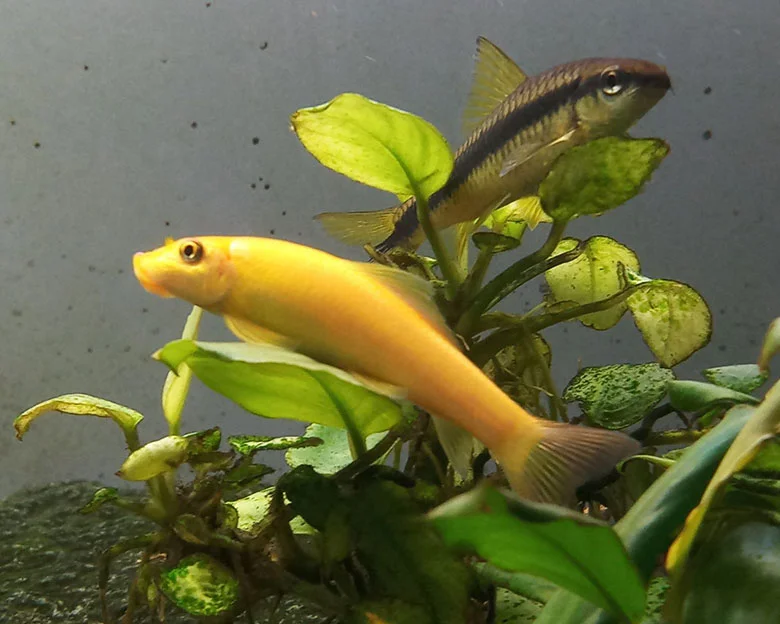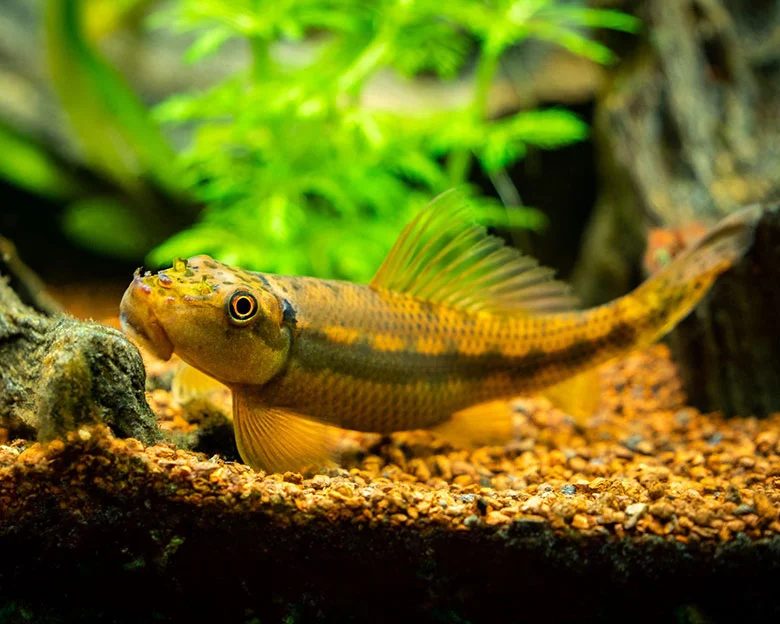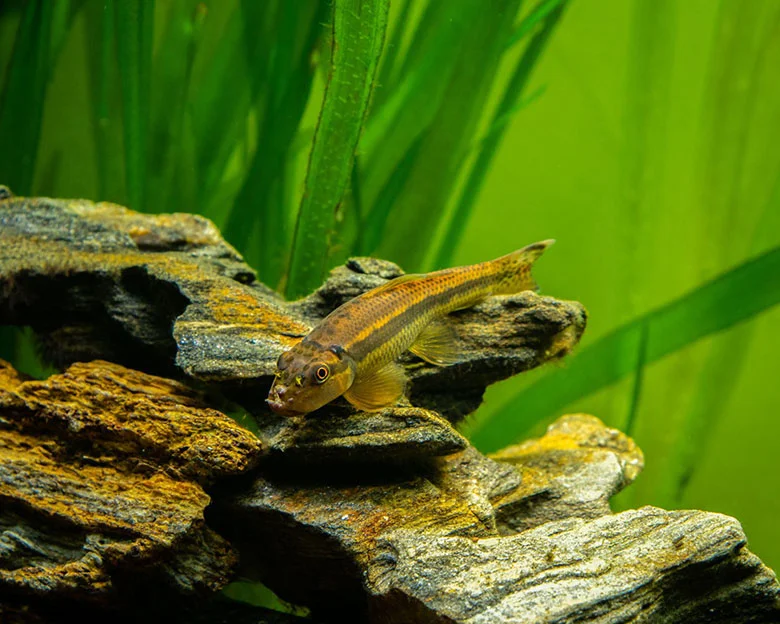If you’re an aquarium enthusiast struggling with excessive algae growth, you’ll be pleased to know that Chinese Algae Eaters are an excellent addition to your tank. These undemanding fish are perfect for beginners and can grow up to 11 inches in the wild.
With their unique underslung mouths that form a sucker, these bottom-dwelling fish are superstars when it comes to keeping your aquarium clean.
But as with any living creature, caring for Chinese Algae Eaters requires attention to detail and the right tankmates. These semi-aggressive fish can live up to 10 years if properly cared for, so it’s important to provide them with a mature tank with pristine water.
In this article, we’ll delve into the physical characteristics, natural habitat, tank requirements, diet and feeding, breeding, mislabeling and misidentification, and aquarium maintenance of these algae-eating superstars. We’ll also share some fun facts about these fascinating fish that you may not have known before.
Key Takeaways
- Chinese Algae Eaters are helpful in getting rid of algae in aquariums and are undemanding, making them a good choice for beginner’s community setup.
- They require a mature, cycled tank with pristine water and a well-established biological filter system, and a 30-gallon tank is recommended as a minimum for a juvenile, while a 50-gallon aquarium or larger is best for adults or a small group of specimens.
- Chinese Algae Eaters are bottom-dwelling and semi-aggressive, preferring clear, shallow waters with moderate flow and grazing on algae, and they can become territorial as they mature and may harass their tankmates.
- Chinese Algae Eaters have a life expectancy of 5-10 years if properly cared for in captivity, and they are omnivorous aufwuchs grazers that can be fed high-quality flake food, algae wafers, and small crustaceans.
Overview

If you’re looking for a low-maintenance, algae-eating fish for your aquarium, Chinese Algae Eaters are a great choice. Not only are they helpful in getting rid of algae in your tank, but they’re also undemanding and a good choice for a beginner’s community setup.
Their long bodies and underslung mouths form a sucker that they use to graze on algae. They prefer clear, shallow waters with moderate flow, and are generally plain in color but have several color morphs.
Compared to other algae-eating fish, Chinese Algae Eaters are bottom-dwelling and semi-aggressive. They can be mistaken for Siamese Algae Eaters, Flying Fox, and Cambodian Logsucker.
While they are loners and spend their time foraging around the bottom of the tank, they can become territorial as they mature and may harass their tankmates. Fast-swimming species are suitable tankmates for Chinese Algae Eaters.
Overall, Chinese Algae Eaters are a great addition to any aquarium due to their helpfulness in algae control and ease of care.
Physical Characteristics
Take note of their long bodies and underslung mouths that form a sucker, as these are distinct physical characteristics of Chinese Algae Eaters. These suckers allow them to stick to surfaces, such as rocks and aquarium glass, while they feed on algae.
Their bodies can grow up to 11 inches in the wild, but they typically reach about 4-5 inches in captivity. Additionally, Chinese Algae Eaters have several color variations, including albino, golden, and black, which are often sought after by aquarium enthusiasts.
The sucker morphology of Chinese Algae Eaters is not only aesthetically pleasing, but also serves an important purpose in their ecology. This adaptation allows them to effectively clean and maintain aquariums by grazing on algae and other organic matter.
As bottom-dwelling fish, they spend most of their time foraging on the substrate, using their suckers to cling to surfaces as they feed. Their color variations also add visual interest to aquariums, making them a popular choice for both novice and experienced aquarists.
Natural Habitat
You may be interested to know that the Chinese Algae Eater’s natural habitat is found in Southeast Asian waters, specifically in countries such as Taiwan, Indonesia, and China. They typically inhabit shallow, clear waters with moderate flow and graze on algae that grow on rocks and other surfaces. They can also be found in slow-moving streams and rivers.
In their natural habitat, Chinese Algae Eaters prefer water conditions that are similar to those found in their captivity. They require pristine water with a pH range between 6.5 to 7.5 and a temperature range between 72°F to 82°F. It’s important to note that they’re sensitive to changes in water conditions, so regular aquarium maintenance is necessary to keep their environment healthy.
Setting up an aquarium that mimics their natural habitat is crucial to their overall well-being.
Tank Requirements

To properly care for Chinese Algae Eaters, it’s important to provide them with a suitable aquarium setup. These fish require a mature, cycled tank with a well-established biological filter system and a minimum of 50 gallons of water.
A long, shallow tank with plenty of swimming and foraging space is preferred. It’s also essential to maintain pristine water quality, so a proper filtration system and water parameters should be maintained. Regular aquarium maintenance, including changing 25% to 30% of the water each week, is necessary to keep the levels of ammonia, nitrites, and nitrates down.
In terms of tank decor, Chinese Algae Eaters prefer clear, shallow waters with moderate flow and graze on algae. A sand/gravel substrate is recommended, along with lighting units, decorations, and plants.
Setting up hiding places such as caves, rocks, and driftwood will help create a comfortable environment for these bottom-dwelling fish. However, it’s important to avoid sharp objects and decorations that may tear their fins or damage their underslung mouths.
By providing a suitable aquarium setup, you can ensure that your Chinese Algae Eaters will thrive and live a healthy life in your care.
Diet and Feeding
Feeding your Chinese Algae Eaters a varied diet is important for their health and well-being. While they are primarily known for their ability to graze on algae, they are also omnivorous and require a mix of plant and animal-based foods to meet their nutritional requirements. In nature, they feed on algae, phytoplankton, zooplankton, insect larvae, and periphyton. In captivity, they can be fed high-quality flake food, algae wafers, and small crustaceans like brine shrimp or daphnia.
To ensure your Chinese Algae Eaters receive a balanced diet, you can follow the feeding schedule and table below as a guide. It is important not to overfeed, as this can lead to health problems and poor water quality. A good rule of thumb is to feed small amounts of food twice a day and monitor their behavior and appearance for signs of good health or potential health problems. By providing a varied diet and monitoring their feeding habits, you can help your Chinese Algae Eaters thrive in their aquarium environment.
| Food Type | Frequency | Amount |
|---|---|---|
| High-quality flake food | Daily | Small pinch |
| Algae wafers | 2-3 times per week | 1 wafer per fish |
| Small crustaceans (e.g. brine shrimp, daphnia) | 1-2 times per week | Small amount |
| Fresh vegetables (e.g. zucchini, cucumber) | 1-2 times per week | Small slice |
| Frozen or live foods (e.g. bloodworms, mosquito larvae) | 1-2 times per week | Small amount |
Health and Disease
Now that you know what Chinese Algae Eaters eat, it’s important to understand how to keep them healthy. Unfortunately, these fish are prone to a variety of health issues, which can be a challenge to treat.
Common health issues for Chinese Algae Eaters include Ich (White Spot Disease), skin and gill flukes, fungal infections, and bacterial infections. These illnesses can be caused by a variety of factors, including poor water quality, stress, and overcrowding. It’s important to keep a close eye on your fish and take action at the first sign of trouble.
However, it’s also worth noting that Chinese Algae Eaters are sensitive to many commonly-used fish medications, which can make treating them even more challenging. As such, it’s important to consult with a veterinarian or experienced fishkeeper before administering any medication to your fish.
To keep your Chinese Algae Eaters healthy, there are a few steps you can take. First, make sure to maintain a clean and well-filtered tank. Regular water changes and tank cleanings can go a long way in preventing illness. Additionally, it’s important to provide a varied and nutritious diet to keep your fish healthy and strong.
Finally, if you do notice any signs of illness, make sure to take action quickly and seek out the advice of an experienced professional. By taking these steps, you can help ensure that your Chinese Algae Eaters live long, healthy lives.
- Poor water quality can lead to a variety of health issues for Chinese Algae Eaters.
- It’s important to keep a close eye on your fish and take action at the first sign of trouble.
- Chinese Algae Eaters are sensitive to many commonly-used fish medications.
- Maintaining a clean and well-filtered tank is crucial for keeping your fish healthy.
- Providing a varied and nutritious diet can also help prevent illness.
Behavior and Temperament
You may notice that your Gyrinocheilus Aymonieri is a relatively solitary fish that spends most of its time foraging around the bottom of the tank. They are not particularly active swimmers and may become stressed if housed with fast-moving fish. As they mature, they can become territorial and may bully other fish in the tank.
To manage aggression in Chinese Algae Eaters, it is best to provide them with plenty of hiding spaces and territories to claim. Fast-swimming fish may not be suitable tankmates for Chinese Algae Eaters, as they may become targets of aggression. Compatible tankmates include slow-moving or bottom-dwelling fish, such as Corydoras or Otocinclus catfish. It is important to monitor the behavior of all fish in the tank and remove any individuals that are being bullied or harassed.
Breeding
To breed Gyrinocheilus Aymonieri, one must use reproductive hormonal agents, as it’s a challenging process not commonly done in home aquariums.
This species is notoriously difficult to breed, and there are several challenges that must be overcome to successfully breed them. One of the challenges is that they are not social animals and may become territorial and aggressive towards each other during breeding.
Additionally, they require specific water conditions, including a pH range from 7.0 to 8.0, and a water temperature of around 75 to 80 degrees Fahrenheit.
Another challenge to breeding Chinese Algae Eaters is that they are hard to sex. Males are typically larger and more colorful than females, but it can still be challenging to differentiate between the sexes.
Once the fish are properly sexed, the next step is to administer hormonal agents to stimulate breeding. This process typically involves injecting the fish with hormones to induce spawning.
Despite the challenges, successful breeding can result in a new generation of Chinese Algae Eaters, which can be a rewarding experience for experienced fish keepers.
Mislabeling and Misidentification
If you’re looking to purchase a fish labeled as a Chinese Algae Eater, be aware that mislabeling and misidentification are common issues in the aquarium trade. This species is often confused with other similar-looking fish, such as Siamese Algae Eaters, Flying Fox, and Cambodian Logsuckers.
To avoid purchasing the wrong fish, it’s important to learn how to correctly identify Chinese Algae Eaters. Mislabeling prevention can be achieved by purchasing fish from reputable dealers who are knowledgeable about the species they sell.
It’s also important to research and compare the physical characteristics of Chinese Algae Eaters to those of other similar fish species. Some identification techniques include observing the body shape, coloration, and markings of the fish, as well as the shape and location of the mouth and fins.
By taking the time to learn about and correctly identify Chinese Algae Eaters, you can ensure that you are providing the proper care and environment for your fish.
Aquarium Maintenance

Maintaining a healthy aquarium for these bottom-dwelling fish requires regular cleaning and water changes. It’s essential to use an aquarium vacuum to remove fish waste and decomposing organic matter from the tank and substrate each week. Additionally, changing 25% to 30% of the aquarium water is necessary to maintain a healthy environment for Chinese Algae Eaters.
It’s also important to rinse the filter media in tank water and change the filter cartridges when required. These steps will help keep the water clean and free of toxins, preventing the fish from getting sick.
In addition to regular cleaning and water changes, there are other tips for preventing diseases in Chinese Algae Eaters. Before adding fish, it’s necessary to test the water to make sure it doesn’t contain any ammonia or nitrites. Low levels of nitrates are to be expected, as long as the levels don’t exceed 20 parts per million (ppm).
It’s also important to keep the water temperature stable and provide a healthy diet for the fish. By following these guidelines for aquarium maintenance and disease prevention, you can ensure that your Chinese Algae Eaters live a long and healthy life in your aquarium.
Fun Facts
Did you know that Chinese Algae Eaters are farmed as food fish in their homeland and used in Cambodian cuisine? While they are commonly kept as aquarium pets in other parts of the world, their popularity as a source of food in Southeast Asia is undeniable.
Here are some other interesting facts about Gyrinocheilus Aymonieri:
- Chinese Algae Eaters are not actually related to true algae-eating fish like the Siamese Algae Eater. Instead, they are members of the carp family and are known for their voracious appetite for algae.
- In addition to eating algae, these fish are also able to scrape off and consume the biofilm that can accumulate on aquarium surfaces. This makes them an important part of maintaining a healthy tank environment.
- Chinese Algae Eaters are known for their long lifespan, with some individuals living up to 10 years in captivity.
- These fish can be quite territorial and may become aggressive towards other bottom-dwelling species as they mature. It’s important to provide them with plenty of space and hiding spots in the aquarium to prevent conflict.
Frequently Asked Questions
Are Chinese Algae Eaters Compatible With All Types Of Fish?
When considering tankmates for Chinese Algae Eaters, compatibility concerns arise due to their semi-aggressive behavior and territorial tendencies. Fast-swimming species are best. Their feeding habits consist of grazing on algae and omnivorous aufwuchs, but they can be fed high-quality flake food and algae wafers in captivity.
What Is The Ideal Water Temperature For Chinese Algae Eaters?
The ideal water temperature for Chinese Algae Eaters is between 72-79°F. Benefits of having algae eating fish include clearer water and reduced maintenance. Tips for maintaining water temperature in aquariums include using a heater and monitoring water temperature regularly.
Can Chinese Algae Eaters Survive In Brackish Water?
Chinese Algae Eaters cannot survive in brackish water as they are freshwater fish. Keeping them in brackish water can lead to stress and health issues. Benefits of keeping Chinese algae eaters include their ability to control algae, but common misconceptions include that they can live in brackish water.
How Often Should The Aquarium Water Be Changed?
For optimal water quality maintenance, change 25-30% of your aquarium’s water every 2-4 weeks. Use an aquarium vacuum to remove waste and organic matter from substrate. Rinse filter media and change cartridges as needed.
What Is The Maximum Age That A Chinese Algae Eater Can Live Up To?
Chinese Algae Eaters have a life expectancy of 5-10 years if cared for properly. They are difficult to breed and require hormonal agents. A 50-gallon tank or larger is necessary for adults, and they should be fed a varied diet of algae, phytoplankton, and small crustaceans.

